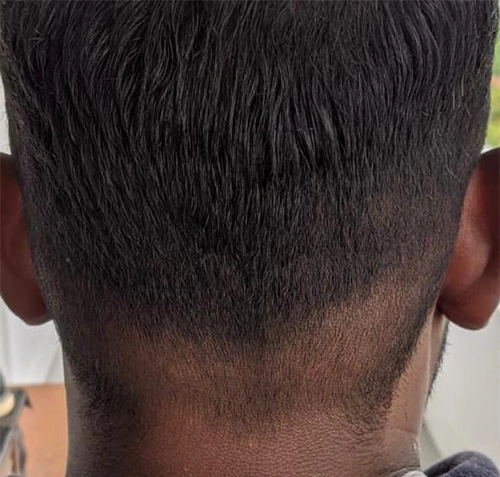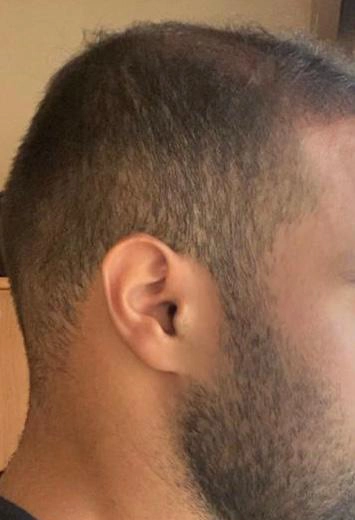

Retrograde alopecia, often overlooked in discussions about hair loss, is a distinctive form that primarily impacts the lower neck region known as the nape and the sides of the scalp just above the ears. This condition is particularly prevalent among patients grappling with hereditary hair loss.
Despite its prevalence, retrograde alopecia remains relatively unfamiliar to many. Surprisingly, statistics suggest that about two out of three individuals dealing with hair loss also contend with some degree of retrograde alopecia, often overshadowed by more apparent male patterned hair loss issues.
Much like typical male patterned hair loss, retrograde alopecia can present itself in various areas of the scalp, exhibiting varying levels of severity. However, the distinguishing factor is that these affected regions are confined to the back and sides of the scalp, specifically below the defined borders in the Norwood Hamilton hair loss chart.
Commonly termed "vertical alopecia," retrograde alopecia characteristically involves thinning and reduced density in a vertical manner. It typically progresses from the nape of the neck and ascends into the lower occipital zone, which is considered the traditional donor area for hair transplants. In rare instances, it may even extend to the occipital bone.
Alternative presentations of retrograde alopecia may feature vertical thinning on either side of the scalp above the ears. This results in a noticeable demarcation between lower density hair closer to the ears and higher density hair further up the scalp. In certain cases, this higher density hair forms a narrow band that should be approached with caution in any surgical hair restoration procedure.

Understanding the symptoms of retrograde alopecia is crucial for timely identification and effective management of this often underestimated form of hair loss. These include:
Retrograde alopecia stems primarily from hereditary factors, with a strong genetic predisposition to hair loss being a key contributor. Patients with a family history of male pattern baldness or other hereditary alopecia forms are more prone to developing retrograde alopecia. The influence of genetics plays a pivotal role in determining the susceptibility of specific patients to this unique form of hair loss.
Beyond hereditary factors, hormonal imbalances also play a significant part in the development and progression of retrograde alopecia. Fluctuations in androgen levels, a group of hormones that includes testosterone, can impact the hair follicles, leading to thinning and eventual loss in the nape and sides of the scalp.
Additionally, environmental factors, such as exposure to certain toxins or pollutants, may exacerbate the condition, especially in individuals genetically predisposed to retrograde alopecia. Understanding the multiple causes of this condition is crucial for devising targeted interventions and effective hair loss treatment strategies.
Diagnosing retrograde alopecia involves a meticulous process, blending clinical expertise and advanced tools to unravel its unique signature patterns. Dermatologists or hair loss experts conduct a thorough examination, scrutinizing specific areas such as the nape and sides above the ears for characteristic thinning patterns. The patient's medical history, with a keen focus on familial hair loss, provides invaluable insights into potential hereditary factors.
During the scalp examination, dermatologists scrutinize affected areas for signs of inflammation, scarring, or follicular damage. Utilizing magnification devices, they delve into the minutiae of hair follicles, assessing their health and searching for distinctive markers of retrograde alopecia.
A non-invasive hair pull test involving gently tugging a small bundle of hair to evaluate shedding levels is conducted. In retrograde alopecia, where weakened hair follicles are common, the hair may easily dislodge. This test becomes a valuable tool for dermatologists, providing insights into the severity of the condition and facilitating the tracking of its progression.
In certain scenarios, a scalp biopsy is deemed necessary to confirm the diagnosis definitively. This procedure entails taking a small scalp tissue sample, examined under a microscope. Through this, dermatologists assess hair follicle health, identify potential inflammation or scarring, and eliminate alternative causes of hair loss.

Retrograde alopecia exhibits distinctive patterns, adding complexity to its recognition and understanding. Beyond its presence on the lower neck (nape) and the sides of the scalp above the ears, this unique form of hair loss can extend its reach to the lateral temporal region, creating thinning in the frontal sides of the scalp.
Interestingly, retrograde alopecia doesn't always stop at the sideburns; it might continue above them without specifically affecting this facial hair feature. In some instances, the sideburns themselves may experience partial effects, highlighting the varied nature of this condition. One intriguing manifestation of retrograde alopecia is the formation of an "arch." This arch not only encompasses the areas above the ears but also extends backward.
Treating retrograde alopecia, a distinct manifestation of hair loss, necessitates a comprehensive understanding of its treatment modalities. These include:
Retrograde alopecia is generally considered a permanent condition, particularly when influenced by hereditary factors. The genetic predisposition to hair loss and the progressive nature of retrograde alopecia suggest that, without intervention, the condition may persist over time.
While treatments such as minoxidil, finasteride, and hair transplant surgery can help manage and slow down the progression, a complete reversal may not always be achievable. Early detection and proactive management play crucial roles in addressing retrograde alopecia, emphasizing the importance of seeking timely intervention to minimize long-term impact.
The reversal of retrograde alopecia remains a challenging prospect, particularly due to its association with genetic factors. While various treatments, including minoxidil, finasteride, and surgical interventions, aim to slow down the progression and promote hair growth, achieving a complete reversal may be limited. The effectiveness of these interventions varies among individuals, and success often hinges on factors such as the stage of retrograde alopecia, the chosen treatment modality, and the patient's response to therapy. Early detection and proactive measures are the key to mitigate the impact of retrograde alopecia and potentially achieving partial restoration.
Retrograde alopecia confines its impact to specific regions of the scalp, namely the sides above the ears and the nape. For patients grappling with this condition, the prospect of surgical hair restoration may be an option. However, the progressive nature of retrograde alopecia poses challenges over time, diminishing the overall donor supply. As a result, prospective patients must carefully manage their expectations and goals in light of the condition's evolving nature.
Thinning in the permanent donor region is a common occurrence for patients with retrograde alopecia. Follicles from this area, essential for hair transplant surgeries, may not be viable due to potential thinning or shedding in the future. Consequently, patients with thinning in the permanent donor region may not be ideal candidates for surgical interventions. Those suspecting retrograde alopecia or experiencing a diffuse thinning pattern are advised to seek an in-person evaluation by a hair loss expert before undergoing a hair transplant procedure.
Hair transplant procedures can be considered for patients with mild retrograde alopecia, particularly when the occipital region remains unaffected. The key determinant is the availability of a sufficient number of intact grafts in the safe donor area. Nonetheless, it is imperative for these individuals to undergo a comprehensive evaluation by a dermatologist before making decisions regarding hair transplant surgery, ensuring a well-informed approach.
The presence of retrograde alopecia can significantly impact the donor area for a hair transplant. Retrograde alopecia primarily affects the sides above the ears and the nape, areas commonly used as donor sites for hair transplant procedures. The progressive nature of retrograde alopecia diminishes the overall donor supply over time.
Additionally, it is highly recommended that the finer hairs found in an area of the scalp affected by retrograde alopecia to be excluded from any hair transplant procedure as they are sometimes mistakenly harvested for their finer caliber diameter. The common purpose is to use them for the frontal hairline, which ultimately leads to failure since they are being miniaturized, and either does not survive the transplantation process or fail to continue to grow after hair transplantation due the issue of continued miniaturization and eventual follicular death.
As a result, patients with retrograde alopecia may need to carefully adjust their expectations and goals for hair transplant procedures, considering the evolving nature of the condition and potential limitations in the donor area.
If you suspect you have retrograde alopecia, seeking professional evaluation is essential. Dermatologists such as Dr. Civas and Dr. Akpınar at Civas Hair Transplant in Turkey possess the expertise to conduct thorough examinations, including scalp inspections, hair pull tests, and, if necessary, scalp biopsies.
At Civas Hair Transplant, a dedicated team of specialists employs state-of-the-art diagnostic techniques to accurately identify retrograde Alopecia and determine the most suitable intervention strategies. Early detection is crucial, and the dermatologists at Civas Hair Transplant are equipped to provide personalized assessments, ensuring that appropriate steps are taken to manage the condition effectively.
Don't hesitate to consult with the experts at Civas Hair Transplant for a comprehensive evaluation and tailored guidance on addressing retrograde alopecia using the form below: Online Consultation Form
I visited Dr Civas’ Hair Transplangt Center twice; first time in 2021 and recently in February 2023. I was referred to the clinic by a friend who had a great experience a{...}
12.08.2023I have just had a hair transplant and am amazed by the professionalism and super service, from the first contact to the operation and following checkups. Everyone has bee{...}
07.09.2023The trip to Ankara and the clinic was great. The clinic staff was friendly and took good care of me throughout the trip. A little over a year has passed since the operati{...}
07.09.2023